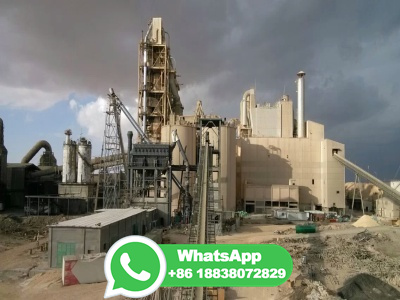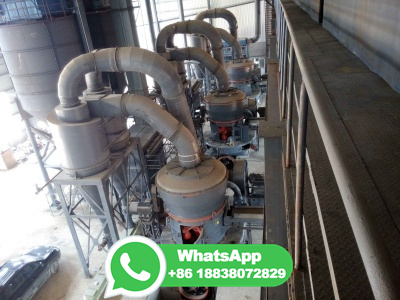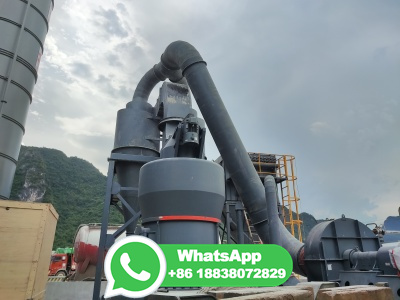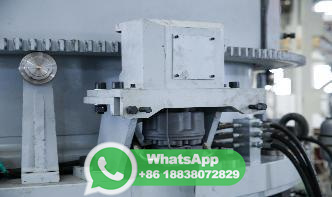
Cement is manufactured through a closely controlled chemical combination of calcium, silicon, aluminum, iron and other ingredients. Common materials used to manufacture cement include limestone, shells, and chalk or marl combined with shale, clay, slate, blast furnace slag, silica sand, and iron ore. These ingredients, when heated at high ...
WhatsApp: +86 18838072829
Abstract. Energy consumption is a crucial parameter in plant performance and a critical factor for optimization. From a control point of view, factors such as nonlinear, multivariable dynamics ...
WhatsApp: +86 18838072829
Cement production is one of the most energyintensive manufacturing industries, and the milling circuit of cement plants consumes around 4% of a year's global electrical energy production. It is ...
WhatsApp: +86 18838072829
handled by the plant's maintenance crew. Upgrading the classifier and baghouse involves capital expenditure with a high benefit to cost ratio. Optimization is especially important when multiple products are being produced. Operation and Elements of a ClosedCircuit Ball Mill System . Cement ball mills typically have two grinding chambers.
WhatsApp: +86 18838072829
Cement plant motor up to kV and 25 MW. Cement plant motor manufacturing is one of our main product focuses. Cement mills, fans, shredders in the production of cement, particularly large and efficient motors are required for the most diverse processes. MENZEL offers individual motor solutions for all applications in the cement industry up ...
WhatsApp: +86 18838072829
CEMENT PLANT TALK001 By: Er. Bilal Common Problems in Cement Plant One Issue from Each Section If You are facing a typical problem in your cement plant, comment us we will include that in our future issues. Quarrying: Wide variation (standard deviation) in raw material composition Crushing: Wide variation in crushed material size.
WhatsApp: +86 18838072829
been a challenging task for cement plant operators. These days, a computerbased pyro control system is not merely nice to have, it is a ... material transportation) cannot be handled well by PID's. Furthermore, the process contains ... to ball mills with dynamics changing in 1520 minutes, vertical roller mills have dynamics changing in 24
WhatsApp: +86 18838072829
Cemex own a total of 61 plants; 52 active integrated plants and nine active grinding plants which yields a total of /yr of cement capacity. It operates 13 plants and 46 cement terminal in the united states. Cemex headquarter based in Houston. https://
WhatsApp: +86 18838072829
The Cement Plant Operations Handbook is a concise, ... Materials analysis 19. Plant capacity summary 20. Storage capacity 15. Cement plant construction and valuation 244 1. New plant construction 2. ... Clinker in transit to the finish mills should be cooler than 100˚C. It is, however, liable to be at a ...
WhatsApp: +86 18838072829
In the whole process of cement production, the electricity consumption of a raw material mill accounts for about 24% of the total. Based on the statistics of the electricity consumption of the raw material mill system of 1005 production lines in China between 2014 and 2019, it is found that the average electricity consumption of the raw material preparation process of all clinker production ...
WhatsApp: +86 18838072829
Materials ground Portland clinker is the main constituent of most cements. In Portland cement, a little calcium sulfate (typically 310%) is added in order to retard the hydration of tricalcium aluminate. The calcium sulfate may consist of natural gypsum, anhydrite, or synthetic wastes such as fluegas desulfurization gypsum.
WhatsApp: +86 18838072829
India is the world's second largest producer of cement and produces more than 8 per cent of global capacity. Due to the rapidly growing demand in various sectors such as defense, housing, commercial and industrial construction, government initiative such as smart cities PMAY, cement production in India is expected to touch 550600 million tones per annum (MTPA) by the end of year 2025.
WhatsApp: +86 18838072829
The #1 issue for coal mill operators is stickiness or coal buildup on all the material handling equipment surfaces, including the mill feeder. Coal remains a common fuel choice for firing cement kilns in North America. Most plants receive their raw coal in a form that requires onsite grinding, using VRM's along with other mill types.
WhatsApp: +86 18838072829
Extraction and processing. Raw materials employed in the manufacture of cement are extracted by quarrying in the case of hard rocks such as limestones, slates, and some shales, with the aid of blasting when necessary. Some deposits are mined by underground methods. Softer rocks such as chalk and clay can be dug directly by excavators.. The excavated materials are transported to the crushing ...
WhatsApp: +86 18838072829
Clinker grinding technology is the most energyintensive process in cement manufacturing. Traditionally, it was treated as "low on technology" and "high on energy" as grinding circuits use more than 60 per cent of total energy consumed and account for most of the manufacturing cost.
WhatsApp: +86 18838072829
Advanced process control analytics optimize cement kiln operation, alternative fuel use, mills and blending How advanced process control () and related optimization strategies can help cement manufacturers to reap the real efficiency benefits of digital technology, without sacing stability or quality, even as a business changes and grows.
WhatsApp: +86 18838072829
Cement plants are typically constructed in areas with substantial raw materials deposits ( 50 years or longer).There are almost 207 cement manufacturing plant in INDIA in 2014 spread all over India. ... Fly Ash are fed into respective hoppers of the grinding mills from which required proportion of these materials are fed to the mills ...
WhatsApp: +86 18838072829
Cement production consumes a huge amount of thermal and electrical energy and generates significant amounts of greenhouse gases, such as CO2. Managers must continuously take actions to increase equipment efficiency, reduce the use of traditional fuels and introduce more alternative raw materials.
WhatsApp: +86 18838072829
Feed material from the mill that is dry and fine; The water injection contributes to helping form the material bed on the grinding table. The spray of the water spear is adjusted depending on the ...
WhatsApp: +86 18838072829
Cement is created by heating crushed limestone with clay, slate, blast furnace slag and other materials, then cooling and grinding the resultant clinker to create a fine powder. Most modern cement plants use a dry process which is more thermally efficient than the older wet process. The process consists of the following stages:
WhatsApp: +86 18838072829
{"payload":{"allShortcutsEnabled":false,"fileTree":{"118":{"items":[{"name":"00 mining equipment companies in ","path":"118/00 mining equipment companies in ...
WhatsApp: +86 18838072829
Operators of cement plants worldwide face the challenge to create their systems more efficient and reliable. Even though the production and consumption of this material is quite stable in Europe, there is a continuously growing demand in Africa, North America and Asia.
WhatsApp: +86 18838072829
Initially, this focused on grinding coal and the cement raw materials, with the adoption of vertical roller mills for cement product grinding with its finer grinding requirements coming more ...
WhatsApp: +86 18838072829
Grinding occurs at the beginning and the end of the cement making process. Approximately tonnes of raw materials are required to produce 1 tonne of finished cement. The electrical energy consumed in the cement making process is in order of 110 kWh/tonne and about 30% of which is used for the raw materials preparation and about 40% for the ...
WhatsApp: +86 18838072829
Learning Path. Module 1: Welcome and Plant Safety. Module 2: Grinding Systems and Mill Components. Module 3: Ball Mill Inspection and Lubrication. Module 4: Ball Mill Drives. Module 5: Ball Mill Separators, Types, and its Maintenance. Module 6: Fan Design and Applications. Module 7: Introduction to Conveyors. Module 8: Ball Mill Dust Collector.
WhatsApp: +86 18838072829
mills, the objectives are to grind and dry the raw materials and produce a homogenous raw meal from a number of components that are sometimes variable in themselves.
WhatsApp: +86 18838072829
With the increase of cement mill specifications and the requirement of energy saving, high yield, and high quality of cement grinding plant, the closedcircuit grinding is an inevitable trend of cement grinding essential equipment of a closedcircuit grinding system is a cement classifier, also known as a cement function of the cement classifier is to select the granules ...
WhatsApp: +86 18838072829
Power and fuel are the primary cost of cement production (about 30% of the total cost). Among them, electricity and coal as the main energy consumption have a direct impact on the running of the cement plant. The electricity is used in many stages from raw material crushing to clinker grinding. It supports the operating of the whole cement ...
WhatsApp: +86 18838072829
Cement industry uses a number of wastes and byproducts as supplementary raw materials in cement raw mix which are referred to as alternative raw materials. ... energy consumption in various parts of the cement plant, such as kilns, mills, and crushers. This realtime data allows operators to identify pilferage processes or equipment and ...
WhatsApp: +86 18838072829
The cement is now ready for use in construction projects. The flow sheet of cement manufacturing is given in Fig. Kiln feed is subjected to successive physical and chemical reactions as its temperature rises gradually as shown in Table Raw Material The major raw materials used as a source of CaO for cement manufacturing are
WhatsApp: +86 18838072829